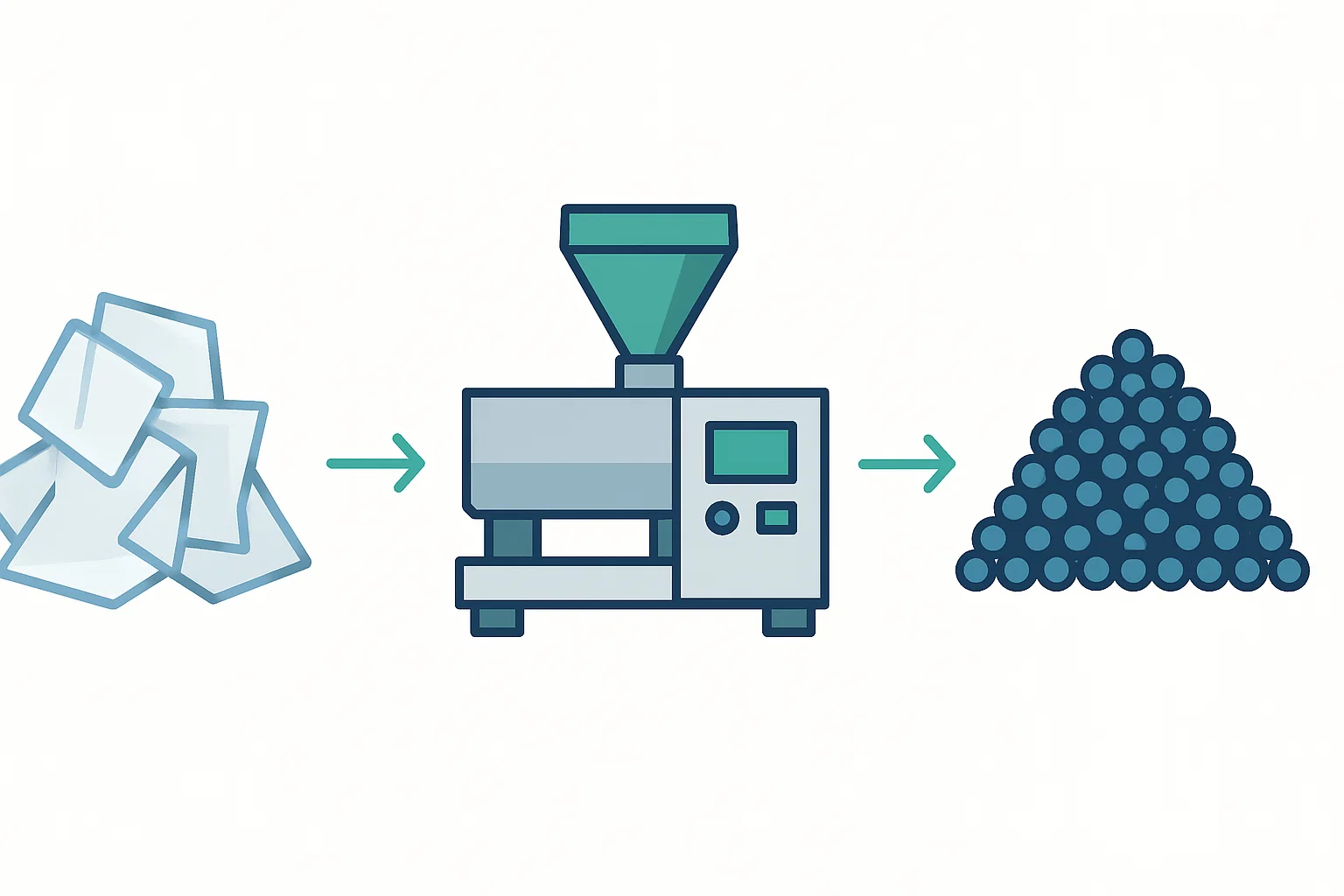In modern manufacturing and packaging, Biaxially Oriented Polypropylene (BOPP) film is a cornerstone material. Prized for its exceptional clarity, strength, and moisture resistance, it is ubiquitous in food packaging, labels, and laminates. However, this prevalence generates a significant stream of post-industrial scrap—trimmings, roll ends, and misprints—that presents both a challenge and a substantial opportunity.
For manufacturers, discarding this high-quality material is not just an environmental concern; it’s a direct loss of potential revenue. The solution lies in efficient recycling, a process that transforms clean, uniform industrial scrap back into high-value raw material. This guide provides an in-depth look at the process of recycling post-industrial BOPP film, with a focus on the critical role of the Plastic granulator. As specialists in recycling technology, we at Rumtoo Machine are here to illuminate the path from waste management to profit generation.
Understanding the Unique Challenge of Recycling BOPP Film
Before diving into the solution, it’s crucial to understand why BOPP film can be tricky to handle. Unlike rigid plastics, film scrap has several characteristics that require specialised equipment and processes:
- Low Bulk Density: BOPP film scrap is light, fluffy, and voluminous. This makes it difficult to feed consistently into a standard extruder, often leading to blockages and inefficient processing.
- High Surface Area: The large surface area of the film can trap air and moisture. If not properly managed, this can lead to voids and degradation in the final recycled pellets.
- Contamination from Inks and Coatings: Even in a relatively clean post-industrial environment, printed films introduce inks, lacquers, and sometimes thin metallic layers. These volatiles must be removed during recycling to ensure the quality of the end product.
- Tendency to Stretch: The inherent elasticity of BOPP means it can stretch and wrap around rotating components in shredders or grinders if the equipment is not designed specifically for film.
Addressing these challenges is the first step towards a successful recycling operation. Fortunately, with the right technology, they are entirely surmountable.
The Post-Industrial Advantage: A Cleaner Path to Recycling
It is important to distinguish between post-industrial and post-consumer waste. Post-industrial BOPP scrap, generated within the factory, is a recycler’s ideal feedstock. It is typically:
- Homogeneous: Consisting of a single material type (BOPP) without contamination from other plastics.
- Clean: Free from food residue, dirt, and other common post-consumer contaminants.
- Consistent: Available in predictable quantities and forms (e.g., edge trims, off-spec rolls).
This purity means the recycling process can be streamlined, often bypassing intensive washing stages required for post-consumer waste. This results in a higher quality recycled pellet and a more cost-effective operation—a key consideration for any manufacturer looking to optimise their resource management.
The Step-by-Step BOPP Film Recycling Process
Transforming BOPP film scrap into uniform, reusable pellets involves a multi-stage process. Each step is designed to prepare the material for the next, culminating in the extrusion stage where the magic truly happens.
Step 1: Material Collection and Sorting
The process begins at the source. Segregating BOPP scrap from other production waste (like paper cores, other polymers, or general refuse) is paramount. A clean, single-stream feedstock is the foundation of high-quality output. For post-industrial operations, this is often as simple as having dedicated bins at production lines where trimmings and off-cuts are generated.
Step 2: Size Reduction (Shredding or Crushing)
The light, bulky film needs to be densified and reduced to a uniform, manageable size. A heavy-duty shredder or crusher designed for soft plastics is used for this. The goal is to create small, consistently sized flakes or “fluff.” This step is critical for ensuring a stable and continuous feed into the pelletizing system. Companies like Rumtoo Machine often integrate this stage directly with the pelletizer to create a seamless, automated workflow.
Step 3: Agglomeration and Feeding
This is where specialised technology comes into play to overcome the low bulk density of the film scrap. The shredded film is fed into a cutter-compactor or agglomerator, which is often integrated into the feed hopper of the Plastic granulator. This unit uses frictional heat to pre-heat, dry, and densify the material into a more solid, dough-like state. This densified material can then be fed directly and consistently into the extruder screw, preventing bridging and ensuring a smooth, high-output process.
Step 4: Extrusion, Degassing, and Filtration
This is the heart of the recycling system. The densified BOPP material enters the barrel of the extruder.
- Melting and Homogenising: A precisely engineered screw rotates within the heated barrel, conveying, compressing, melting, and homogenising the plastic. The screw design is critical for processing BOPP efficiently without causing thermal degradation.
- Degassing (Venting): To handle printed films, a vented or double-vented extruder is essential. As the plastic melts, inks and moisture turn into gas. The vacuum degassing system removes these volatiles from the polymer melt, preventing bubbles and imperfections in the final pellets. This is a non-negotiable feature for producing top-grade recycled material from printed scrap.
- Melt Filtration: Before the molten plastic can be formed into pellets, it must be filtered to remove any non-plastic contaminants (like carbonised paper fragments or metal dust) that may have slipped through. A high-performance screen changer, whether hydraulic or continuous, ensures a pure melt stream, which is vital for downstream applications.
Step 5: Pelletizing
Once the clean, molten polymer exits the extruder die, it is cut into pellets. The two most common methods for BOPP film are:
- Water-Ring Pelletizing: This is the most popular method for polyolefins like BOPP. As the molten plastic strands exit the die plate, a set of rotating blades cuts them flush against the die face. A ring of water immediately quenches the pellets and transports them to a centrifugal dryer. This system is compact, automated, and produces highly uniform, spherical pellets.
- Strand Pelletizing: In this method, strands of molten plastic are extruded into a water bath for cooling before being fed into a separate pelletizer unit that cuts them into cylindrical pellets. While effective, it typically requires more floor space and operator oversight.
The choice of pelletizing system depends on output requirements, space constraints, and budget. The experts at Rumtoo Machine can advise on the optimal configuration for your specific operational needs.
Choosing the Right Equipment: The Central Role of the Plastic Pelletizing Machine
The success of a BOPP recycling line hinges almost entirely on the quality and configuration of the Plastic granulator. It is not a one-size-fits-all solution. When investing in this core piece of equipment, manufacturers should consider the following features:
- Integrated Cutter-Compactor: For film scrap, this is the most efficient feeding technology. It combines size reduction, drying, and densification into a single unit, ensuring high throughput and stable extrusion.
- Advanced Screw Design: The geometry of the extruder screw must be optimised for the melt characteristics of BOPP to ensure gentle plasticising and excellent mixing.
- Effective Degassing System: A powerful vacuum degassing system is crucial for processing printed or slightly moist film, directly impacting the quality and commercial value of your pellets.
- Robust Filtration: A reliable melt filter is your final quality control gate. The level of automation (e.g., a self-cleaning continuous filter) should align with the expected level of contamination and desired operational uptime.
in Rumtoo Machine, we understand these nuances. Our deep experience in polymer science and mechanical engineering allows us to design and build recycling lines that are not just machines, but complete solutions. For many BOPP film applications, a high-performance Flexibele kunststof monoschroef granulator is the ideal choice, offering a superb balance of efficiency, reliability, and cost-effectiveness. We work closely with our clients to tailor every component, from the feeder to the pelletizer, to match their specific feedstock and production goals.
The Economic and Environmental Dividends
Investing in a robust BOPP film recycling system delivers compelling returns.
- Economic Benefits:
- Reduced Disposal Costs: Eliminates fees associated with landfilling or sending scrap to third-party recyclers.
- New Revenue Stream: High-quality recycled BOPP pellets are a valuable commodity that can be sold on the open market or reused in-house.
- Lower Raw Material Costs: Re-integrating recycled pellets into your production process (where applicable) reduces the need to purchase virgin resin, directly cutting material costs.
- Environmental Benefits:
- Circular Economy Contribution: It closes the loop on plastic waste, turning a linear (make-use-dispose) model into a circular one.
- Reduced Carbon Footprint: Recycling plastic requires significantly less energy than producing virgin plastic from fossil fuels.
- Enhanced Brand Image: Demonstrating a tangible commitment to sustainability and responsible manufacturing strengthens your brand’s reputation with customers, partners, and the community.
Conclusion: Transforming a Liability into a Strategic Asset
Post-industrial BOPP film scrap should no longer be viewed as a waste product. It is a valuable, high-quality resource waiting to be reclaimed. By implementing a well-designed recycling process centred around a high-performance Plastic granulator, manufacturers can unlock significant economic and environmental benefits.
The journey requires technical expertise and the right equipment partner. With our proven technology and client-focused approach, Rumtoo Machine empowers businesses to transform their industrial scrap into a strategic asset, driving efficiency, profitability, and sustainability. Contact our team today to discover how a tailored recycling solution can revolutionise your resource management.
Veelgestelde vragen (FAQ)
1. What is the quality of recycled BOPP pellets, and where can they be used?
The quality of pellets from post-industrial BOPP scrap is exceptionally high, often close to that of virgin resin. This is because the feedstock is clean and uniform. These pellets are highly sought after for applications such as injection moulding (e.g., for making crates, buckets, and furniture parts), extrusion of non-food-contact films and sheets, and as a component in compounding.
2. Can a plastic pelletizing machine handle printed BOPP film effectively?
Absolutely. A key feature to look for is a high-efficiency degassing (venting) system. At Rumtoo Machine, our pelletizers for printed film are equipped with single or double vacuum-assisted vents. These systems effectively extract the volatile gases released from inks and coatings during the melting process, resulting in pure, dense, and high-quality pellets free from porosity.
3. How much floor space is required for a complete BOPP film recycling line?
The footprint varies depending on the desired output and level of automation. However, modern systems are designed to be remarkably compact. A typical line from Rumtoo Machine, featuring an integrated cutter-compactor, extruder, and water-ring pelletizer, can fit into a surprisingly small area. We provide detailed layout drawings during the consultation phase to ensure a perfect fit within your facility.
4. What is the primary difference between a single-screw and a twin-screw extruder for recycling film?
A single-screw extruder is the industry standard for recycling clean, homogenous post-industrial scrap like BOPP. It is highly efficient, cost-effective, and reliable for this application. A twin-screw extruder offers more intensive mixing and is typically used for more complex tasks like compounding (mixing plastics with additives like colourants or fillers) or handling heavily contaminated materials. For most post-industrial BOPP film recycling, a well-designed single-screw machine provides the best return on investment.

